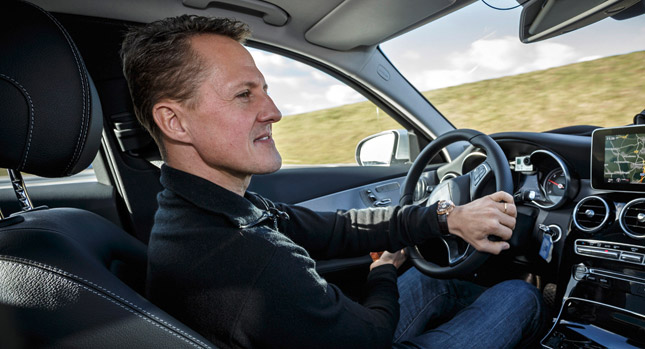Watch Michael Schumacher Test The New 2015 C-Class' Safety Systems [VIDEO]
2013.12.13

Mercedes-Benz has released a video with Michael Schumacher diving the new C-Class at the Mercedes Technology Center in Sindelfingen to see how the car's new assistance systems work.
Schumacher tested out the functions that use a new stereo camera and multi-stage radar sensors.
Assisted by Jochen Hermann, chief engineer responsible for assistance systems and active safety at Mercedes-Benz, Schumacher gave his feedback on the driver’s interaction with the systems and the way they work.
[From Mercedes-Benz]
- COLLISION PREVENTION ASSIST PLUS. At speeds of 30 km/h and above, it issues a visual warning if the gap between the driver's vehicle and the vehicle ahead is too small, with an additional acoustic warning at 7 km/h and above if there is a danger of collision, and provides an adaptive braking assistance function which, depending on the situation, can boost braking if the driver is not braking hard enough. If the driver does not react, now, for the first time in a series-production system, a collision with slower or stopping vehicles ahead when driving at speeds of up to 200 km/h can be prevented or at least minimised by automatic, autonomous partial braking. The system also brakes in response to stationary vehicles at a speed of up to 50 km/h, and is able to prevent rear-end collisions at speeds of up to 40 km/h.
- DISTRONIC PLUS with Steering Assist and Stop&Go Pilot helps the driver to maintain a suitable distance, even in stop-and-go traffic. The steering assistance feature is new and helps the driver with lateral control of the vehicle, even on gentle bends, and offers a traffic jam vehicle following function.
- The PRE-SAFE® Brake provides autonomous braking in the absence of a driver reaction. In typical urban driving scenarios, it can prevent collisions with pedestrians or stationary vehicles at speeds of up to approx. 50 km/h; or, at speeds of up to approx. 70 km/h reduce the impact of such collisions.
- Brake Assist PLUS with Cross-Traffic Assist can, depending on the situation, boost the braking strength applied by the driver, if necessary up to full brake application and, for the first time, can also react to crossing traffic and pedestrians.
- Active Blind Spot Assist issues a visual and - if the indicator is activated - an acoustic warning of the presence of a vehicle in the blind spot area; and can prevent a potential side-on collision by applying the brakes unilaterally at the last moment.
- Active Lane Keeping Assist warns against unintentional drifting across a lane through vibrations of the steering wheel; and if the vehicle actually crosses a lane marking, corrects the vehicle's position through unilateral brake application. It also applies the brakes unilaterally if the vehicle drifts across a lane marking and the neighbouring lane has, for example, oncoming traffic, overtaking or overtaken vehicles in it.
Check out the video below:
More Articles
Copyright © Fooyoh.com All rights reserved.